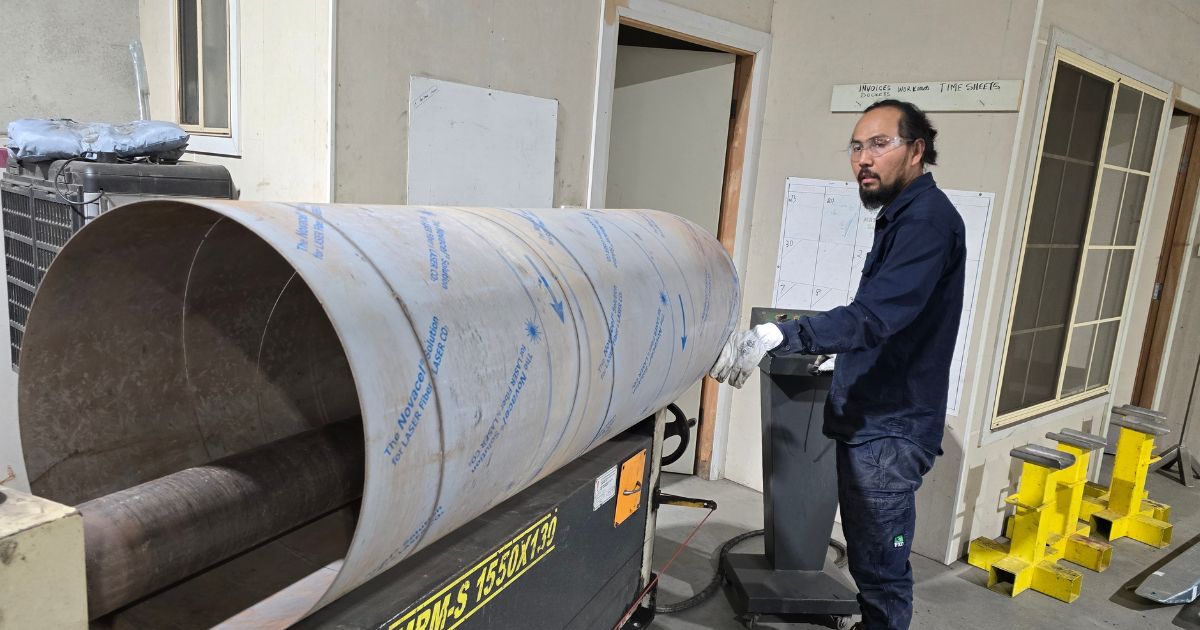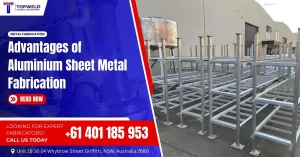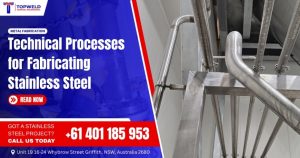Custom sheet metal fabrication is the backbone of modern manufacturing, powering industries from construction and food processing to pharmaceuticals and energy. It involves the cutting, bending, welding, and finishing of flat metal sheets into precise, durable components and products. Without it, everyday items such as appliances, machinery, storage tanks, and medical equipment would not exist in their current reliable forms.
For businesses, understanding how sheet metal fabrication works is essential to making informed decisions when choosing a fabrication partner. It provides clarity on project costs, lead times, and the durability of the end product. For students and professionals entering the industry, it provides a clear overview of the skills and processes required, giving them a strong foundation to build upon as they develop expertise in advanced techniques and specialised materials.
This beginner’s guide to custom sheet metal fabrication will walk you through the key stages, benefits, and applications of the process, highlighting why it remains such a critical element in today’s industrial landscape. Whether you are looking to commission a project or expand your knowledge, this guide will give you the insights you need.
What Is Sheet Metal Fabrication?
Sheet metal fabrication refers to the process of transforming sheet metal into functional parts, assemblies, or finished products through a combination of mechanical and manual techniques. Unlike simple metal cutting or forming, fabrication involves multiple processes that are carefully integrated to produce a final outcome that meets strict specifications.
Unlike mass production, custom sheet metal fabrication focuses on tailored solutions that meet the unique requirements of clients. This means that every project is designed to match the exact needs of an industry, whether it’s the thickness of a tank wall, the shape of a ventilation duct, or the hygienic surface of a food-grade vessel. This high degree of customisation ensures optimal performance and long-term reliability.
The most commonly used materials include:
- Stainless steel – prized for its corrosion resistance and hygienic properties, making it indispensable in food, beverage, and pharmaceutical applications.
- Aluminium – lightweight, durable, and highly workable, ideal for industries where reduced weight improves efficiency, such as transportation and aerospace.
- Carbon steel – strong and cost-effective for structural applications, widely used in construction and heavy machinery.
- Copper and brass – valued for conductivity, ductility, and aesthetic finishes, making them essential for electrical, decorative, and architectural uses.
Each metal is chosen based on its mechanical properties, cost-effectiveness, and suitability for the intended application. This selection process is critical to ensure both efficiency and compliance with industry standards.
1. Design and Planning
Every project begins with design development, typically using Computer-Aided Design (CAD) software. CAD ensures accuracy in dimensions, tolerances, and specifications while allowing engineers and clients to collaborate on functionality and compliance with industry requirements. Advanced software simulations can also predict how metals will behave under stress, heat, and pressure, providing valuable insights before production begins.
Design is often followed by prototyping, where a small-scale model or digital simulation is created to test feasibility before moving into full production. Prototyping helps reduce costly errors, ensures that the final design meets both safety and performance standards, and provides an opportunity to fine-tune features for efficiency. By investing time in the design and planning stage, businesses can save significant costs and avoid production delays down the line.
2. Cutting
The next step involves cutting sheet metal into the required shapes. Precision is crucial to avoid material waste and ensure accuracy, especially when working with costly metals such as stainless steel. A clean cut provides the foundation for the rest of the fabrication process, as errors here can affect all subsequent stages.
Common methods include:
- Laser cutting – highly accurate, capable of producing intricate designs and complex patterns with minimal material wastage.
- Plasma cutting – effective for thicker materials where speed and efficiency are needed.
- Waterjet cutting – ideal when working with heat-sensitive materials, as it uses water and abrasives instead of heat.
- Shearing – cost-effective for straight cuts on thinner sheets.
Modern fabrication shops often rely on CNC (Computer Numerical Control) machines to automate these processes, ensuring consistent results with minimal human error. Automation also increases productivity, enabling businesses to handle large-scale projects more efficiently.
3. Forming and Bending
Once cut, sheets are shaped into their required forms. This step transforms a flat material into a usable component, which may include anything from a tank wall to an automotive panel. Forming requires precision and an understanding of material behaviour to prevent cracks, warping, or other defects.
This is achieved through:
- Press brakes to create precise bends in various angles.
- Rolling machines for cylindrical or rounded shapes, commonly used in tanks, pipes, and silos.
- Stamping and punching for detailed features such as holes, notches, or embossing.
Forming requires careful control to avoid weakening the metal while achieving the desired geometry. For example, bending stainless steel requires specific force calculations to ensure the strength and integrity of the final product are not compromised. This stage demands both technical knowledge and state-of-the-art equipment.
4. Welding and Assembly
The formed parts are then joined together through assembly and welding. This is one of the most critical steps, as it ensures the fabricated pieces become a single, durable structure that can withstand operational stresses.
Different welding techniques may be applied depending on the material and intended use, such as:
- MIG (Metal Inert Gas) welding – efficient and versatile, often used for thicker materials.
- TIG (Tungsten Inert Gas) welding – precise and ideal for stainless steel and aluminium, producing clean and strong welds.
- Spot welding – common for thin sheets in automotive and industrial applications.
In addition to welding, other methods such as riveting, bolting, and fastener installation may be used to complete assemblies. The choice of joining method depends on the structural requirements, industry standards, and the environment where the finished product will be used. This stage is about balancing strength, precision, and efficiency.
5. Finishing
Finishing is where both function and aesthetics are enhanced, giving the fabricated product its final look and protective qualities. Finishing not only improves the appearance but also enhances resistance to corrosion, wear, and other environmental factors.
Common finishing processes include:
- Powder coating and painting – providing durable protective and decorative finishes that improve longevity.
- Galvanising – adding a zinc coating to improve corrosion resistance, commonly used in outdoor or harsh environments.
- Polishing and brushing – for hygienic or visually appealing surfaces, particularly in food-grade and pharmaceutical applications.
- Anodising (for aluminium) – improving surface hardness, colour, and resistance to corrosion.
In industries such as food and beverage or pharmaceuticals, finishing ensures surfaces remain smooth, hygienic, and easy to clean. It also prevents the growth of bacteria and meets compliance requirements for safety and quality. In other industries, such as construction, finishing improves durability and extends the life span of products exposed to varying weather conditions.
6. Inspection and Quality Control
Before delivery, every fabricated product undergoes rigorous inspection and testing. This step is essential for maintaining trust with clients and ensuring compliance with strict industry standards.
Inspection focuses on:
- Dimensional accuracy against original CAD specifications.
- Strength and load-bearing capacity to ensure safety.
- Surface finish quality to guarantee hygiene and aesthetics.
- Compliance with client specifications, certifications, and legal requirements.
Quality control is critical for preventing costly failures and protecting end users. A well-established fabrication company integrates quality management systems throughout the entire process, not just at the end, ensuring consistent excellence in every project delivered.
Advantages of Custom Sheet Metal Fabrication
Custom sheet metal fabrication offers a wide range of benefits, making it the preferred choice for many businesses. By focusing on precision and tailored solutions, it ensures that clients receive exactly what they need rather than settling for generic, off-the-shelf products.
Some of the main advantages include:
- Precision and accuracy – CAD-driven designs and CNC machining ensure reliable results that meet the tightest tolerances.
- Flexibility in design – customised solutions are tailored to unique requirements, supporting innovation and problem-solving.
- Durability and performance – fabricated products are built to withstand demanding industrial conditions, offering long-term reliability.
- Compliance and hygiene – critical in industries such as food, healthcare, and pharmaceuticals where strict standards apply.
- Cost-effectiveness – while initial costs may be higher, custom fabrication reduces long-term expenses through lower maintenance and longer service life.
For businesses, these benefits translate into better productivity, improved safety, and stronger competitiveness in the market.
Applications Across Industries
Sheet metal fabrication is applied in nearly every major industry, showcasing its adaptability and importance. The versatility of metals and fabrication techniques allows products to meet both large-scale industrial needs and specialised custom applications.
Some key examples include:
- Food and beverages: processing equipment, storage tanks, and conveyors, all designed to meet hygiene and durability standards.
- Pharmaceuticals and medical: sterile vessels, cleanroom components, and medical devices requiring the highest levels of precision and cleanliness.
- Construction and infrastructure: roofing, cladding, ductwork, and structural components that ensure safety and functionality in building projects.
- Energy and power: turbines, pipelines, boilers, and heat exchangers that support critical energy production and distribution.
- Automotive and transport: vehicle frames, body panels, brackets, and enclosures that prioritise strength and efficiency.
These examples highlight how integral sheet metal fabrication is to both everyday life and advanced industry operations.
This beginner’s guide to custom sheet metal fabrication highlights the complexity, precision, and value of the process. From initial design to finishing and inspection, each stage plays a critical role in producing durable, high-quality components for diverse industries. The expertise involved ensures that businesses across multiple sectors benefit from strong, reliable, and hygienic products that meet strict standards.
At Topweld General Engineering, we specialise in delivering tailored sheet metal fabrication solutions that combine technical expertise, advanced equipment, and strict quality control. Whether your project is large-scale industrial or highly specialised, our team ensures every product meets the highest standards of performance and reliability. By partnering with us, you gain a fabrication partner dedicated to precision, compliance, and innovation.




